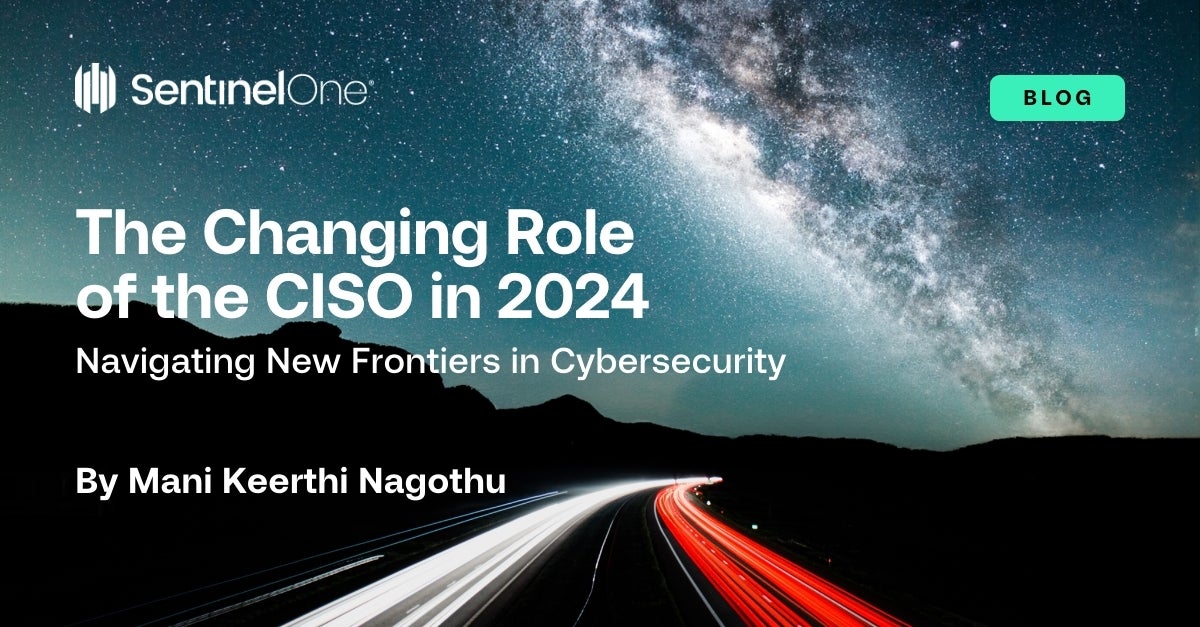As 2024 begins to unfold, the role of Chief Information Security Officers (CISO) is set to evolve as modern enterprises face new challenges in the ever-changing cybersecurity landscape. Once primarily focused on implementing security protocols and conducting periodic risk assessments, CISOs are now expected to be key decision makers, influencing corporate strategy and guiding their organization through the complexities of the current age.
The evolution of the CISO is not only a response to the growing sophistication of cyber threats but also a proactive measure to stay ahead of potential risks. This blog post delves into the evolving role of the modern CISO, from figures of security technical know-how to pivotal visionaries in strategic cybersecurity and business growth.

Changing With the Times | From Technical Gurus to Strategic & Front-Line Leaders
When the role of “chief information security officer” first came into being – recall the role didn’t exist before 1995 – the responsibilities of the CISO were centered around establishing and maintaining security protocols. Those in the role needed deep technical know-how in both networking and operating systems, including experience in implementing firewalls, conducting periodic risk assessments, and ensuring compliance with relevant regulations. The CISO served as a technical gatekeeper, responding to emerging threats as they surfaced.
Over time, as the cyber threat landscape continued to evolve, the CISO’s responsibilities expanded, with increasing involvement in policy development, risk management, and collaborating with other C-level executives to align cybersecurity strategies with broader business objectives.
The Changing Role of the CISO | Establishing Cybersecurity at the Executive Level and Beyond
Although the role of the CISO now can vary widely across organizations depending on their size and nature, it tends to lean much further into executive leadership and risk management, with a prime responsibility to keep C-suites in touch with security risks relating to organizational objectives, strategy and business outcomes.
Depending on the organization, the modern CISO will be involved in most of the following key areas of responsibility to some degree or another.
- Cyber risk management
- Compliance and regulatory adoption
- Strategic business integration
- Crisis management & Incident Response
- Establishing & cultivating a ‘Security First’ business culture
Let’s take a look at each of these in turn.
Cyber Risk Management
Central to the role of many CISOs is the responsibility for adopting a proactive and strategic approach to identify, assess, and mitigate cyber risks. This often includes developing comprehensive risk management frameworks that align with organizational goals.
Engaging actively with executive leadership, CISOs work to articulate the potential impact of cyber threats on business operations, financial stability, and company branding, collaborating where needed with department leads across the organization to foster a culture of cybersecurity awareness and compliance.
Compliance and Regulatory Adoption
CISOs play a central role in ensuring regulatory compliance, which involves both ensuring adherence and understanding the implications of regulations on day-to-day processes and overarching strategies.
Staying knowledgeable of regulatory changes and translating them into actionable policies is a shared responsibility that CISOs undertake to safeguard data privacy and integrity.
In collaboration with legal and compliance experts, CISOs navigate the intricate frameworks of requirements and controls set by GDPR, HIPAA, or PCI DSS, for example, and then tailor security measures to meet these standards. In addition, CISOs are counted on to cultivate a culture of continuous compliance through measures such as conducting regular audits and mechanisms to address and identify gaps.
In doing so, they help to not only mitigate legal and financial risks but also fortify the organization’s reputation and stakeholder trust.
Strategic Business Integration
The evolving nature of the role can be seen in the way that many CISOs are now increasingly viewed as critical enablers in the business ecosystem. In some organizations, their insights and expertise have become invaluable in shaping product development and influencing business strategies by driving technical innovation.
In this regard, they can be key to enhancing relationships with vendors and partners, fostering a security-centric approach in all business interactions and collaborations.
Crisis Management and Incident Response
With cyber threats becoming more sophisticated and pervasive, the modern CISO is not only tasked with preventing security breaches but also with orchestrating a robust incident response (IR) strategy.
They will play a central role in the development and implementation of incident response plans (IRPs), ensuring leaders from all functions are well-prepared in the event of a cyber incident. In many organizations, CISOs collaborate with cross-functional teams, including legal, communications, and IT, to streamline response efforts during a crisis.
In some cases, the role may extend to leading post-incident analyses to understand the root causes and improve response protocols. This typically involves actively engaging with external stakeholders, regulatory bodies, and law enforcement agencies to navigate the legal and reputational ramifications of a security incident.
As crisis managers, CISOs may be expected to steer the organization away from negative fallout after cybersecurity incidents with a strategic and agile approach, minimizing the impact of breaches and maintaining business continuity.
Establishing & Cultivating a ‘Security First’ Business Culture
The modern CISO recognizes the significance of cultivating a robust security culture within the organization. They champion awareness programs, training initiatives, and communication strategies to instill a collective responsibility for cybersecurity among employees.
At the same time, CISOs may be at the forefront of advocating for advanced technologies and innovative solutions to counter evolving cyber threats, leading the evaluation and implementation of cutting-edge tools, artificial intelligence (AI), and machine learning (ML) to fortify their organization’s defenses.
Emerging Trends Impacting CISOs in 2024
The cybersecurity landscape in 2024 brings forth a spectrum of new challenges and technological advancements, necessitating a dynamic and strategic approach from CISOs.
Regulatory Compliance and Transparency: The era of mandatory information sharing is ushered in with stringent cyber laws like the SEC cyber disclosure rule. This shift to obligatory reporting amplifies the need for enhanced cyber transparency, bolstering trust in an organization’s cybersecurity measures.
Security Management Amid Digital Transformation: As businesses rapidly evolve digitally, effective management of security postures is key. CISOs are tasked with maintaining control over digital assets while aligning security strategies with the swift pace of business demands, emphasizing the need for continuous adaptation and learning.
Upgraded Cloud Security: With the rise in data breaches within cloud environments, there’s an increased focus on developing sophisticated cloud security strategies. This trend underscores the importance of comprehensive identity and access management, data encryption, and continuous monitoring to safeguard cloud-based assets.
Enhanced API Security: Following the urgency for cloud security, CISOs are also turning their attention to API security. This involves a meticulous process of identifying all APIs within the organization and assessing whether existing tools suffice in terms of visibility, control, and compliance.
AI-Driven Security Tools: The advancement of AI technology has led to a surge in AI-driven security tools. These tools not only enhance defensive capabilities but also provide strategic advantages in optimizing the deployment of existing talent and resources.
Cyber Resilience: Facing an array of evolving threats, there’s a concerted effort to build a strong security culture and improve detection, prevention, and response capabilities. This includes comprehensive updates to business continuity plans, disaster recovery strategies, and incident response protocols, ensuring an all-encompassing approach to cyber resilience.
These emerging trends underline the need for CISOs to be proactive, adaptable, and strategic. The role of the CISO is progressively evolving, requiring a blend of technical expertise, strategic planning, and leadership skills to navigate the new challenges in the cybersecurity domain effectively.
What Lies Ahead for CISOs?
As paradigms shift in tandem with rapid changes in the cyber threat landscape, proactive CISOs can work to understand these changes and revamp security within their organizations.
We enter 2024 recognizing the importance of addressing not only traditional cybersecurity concerns but also much else that has only recently come over the horizon: the need to secure physical infrastructure, IoT devices, SCADA systems, and ensure the safety of remote personnel. Add to this the new focus on cloud security, AI and stricter regulatory and compliance rules and we face an expansion that reflects the growing complexity of cybersecurity, where the digital and physical realms intersect, demanding a comprehensive approach to secure diverse assets.
Further, the widened scope of responsibilities is extending beyond digital asset management to encompass holistic organizational risk. This approach involves identifying, assessing, and mitigating risks across all facets of the organization, ensuring resilience and continuity in an ever-changing threat landscape. CISOs are now integral to not just securing data but safeguarding the entire organizational ecosystem.
In providing resources, CISOs are equipping themselves with technical tools that aid core functions and support their expanded responsibilities. The arsenal includes technologies for threat intelligence, real-time monitoring, and adaptive defenses. As technology becomes more intertwined with business operations, CISOs will increasingly leverage advanced tools to stay ahead of cyber threats.
Conclusion
The landscape for CISOs in this new year continues to unfold, with emerging trends and innovative technologies impacting their strategies and responsibilities.
The role of CISOs in today’s world is multifaceted and dynamic, going beyond traditional IT security to encompass a wide spectrum of strategic, operational, and leadership responsibilities. As part of the cybersecurity community, CISOs are collectively striving to not only protect their organizations from cyber threats, but also to drive forward-thinking strategies that align with and support business objectives.
SentinelOne’s AI-driven Singularity platform is designed to support CISOs as they safeguard their organizations from current and future threats on all attack surfaces. SentinelOne offers two free eBooks, 90 Days | A CISO’s Journey to Impact – Define Your Role and 90 Days | A CISO’s Journey to Impact – How to Drive Success, as resources for CISOs working to implement best practices in their business. For in-depth expertise and guidance, contact us for more information or book a demo.


